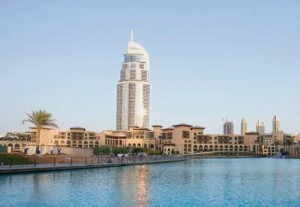By Nicole Walter, Features Editor, Property Monthly www.gulfnews.com
Southern Sun’s Al Manzil and Qamardeen hotels currently average a robust near 80 per cent occupancy, helped by rack rates that are linked to a dynamic pricing model. The earlier that a person books, the cheaper it will be for them, with the rates ranging from Dh500 to Dh1,000 a night. All other things being equal, locational advantages have got a lot to do with the stellar performance.

A fact that Southern Sun is only too willing to concur with. “Our rates as four-star hotels are still 15 to 20 per cent higher than our competitors, there is location value here,” states Richard Weilers, managing director, Southern Sun Middle East. “The recession hit us in November, there was a bit of pressure on rates due to global travellers’ reduced spending power and the beach hotels competing for the corporate side to drive up occupancy.”
The Qamardeen took a little longer to take off due to the work in progress still on at the overall development around it. But this will change shortly, and the hotel is going to get a new boulevard cafe once Emaar has completed the same.
“We will be creating more life on this side of the development — once the whole Downtown area is completed it will become the new centrepoint of Dubai, before people drifted off to DIFC for example.”
The Downtown lifestyle will become key through a lively and potent mix of residential, business and tourism components. The proximity to Business Bay and DIFC adds to its lustre. The upcoming underground boulevard from Dubai Mall via Murooj Rotana will provide a convenient shortcut to DIFC.
“The proportion of density here is just right, there’s not just lots of towers, but a blend of iconic and low-rise traditional architecture,” Weiler cannot stop enthusing. “A brilliant mix for the international business and leisure traveller with a Middle Eastern feel and all the modern conveniences within it.”
On a strong footing
More and more visitors are buying into the argument. While Dubai’s hotel sector has been nudging the mid-60 per cent occupancy level in recent months, hotels in the Downtown have been performing above par.
“The Address has already outperformed the market, enjoying high rates and occupancies, partly thanks to marketing like its tie up with Emirates Airline offering a free night, but also because of the location,” says Adrian Jonklaas, senior consultant at PKF — The Consulting House, who likens the hospitality offerings in the area to the swanky Madinat Jumeirah cluster.
“The opening of the Burj Khalifa itself can only add to that. It will be a must on any tourist’s to-do-list. Not everyone can stay in the Armani (Hotel), so the other hotels will benefit from that.”
When each of the mini-destinations within Downtown will come on-line is unclear, but Jonklaas reckons the Armani Hotel will most likely have an immediate, albeit soft, opening. “We can’t be sure, there most likely remains some unfinished work to the interiors, but we’re fairly confident as it makes sense to make it coincide with the opening of the Burj.”
He bases his prediction on the fact that staff were hired for the hotel back in June: “This is a good sign, hotels tend to hire staff about six months before opening,” Jonklaas adds.
Sure, that’s fine, but will guests have to end up paying a premium rate for lolling in the Burj’s glow?
“If you take history, the Burj Al Arab defied all initial predictions — people are quite happy to spend Dh6,000 to Dh8,000 (a night) to stay in the suites at the ultra-luxury end of the market,” he says. “The Armani falls into that category, and as far as we have heard, its positioning in the market will see it below the Burj Al Arab’s room rates, maybe around Dh3,000 to Dh4,000. The same segment that stays in the Burj Al Arab would also stay in a hotel like the Armani.”
The metro factor
The Dubai Mall metro station, one of the busiest, has already proven Downtown Burj Khalifa ‘s status as a destination magnet. “Being a value integrated town destination will help to overcome what a lot of supply coming into the market could mean for others,” says Adrian Jonklaas of PKF — The Consulting House. “People visit destinations, and the mid-segment of the tourist market will use the Metro to visit the tallest tower in the world.












